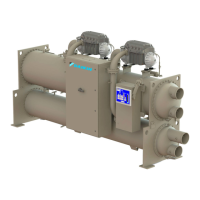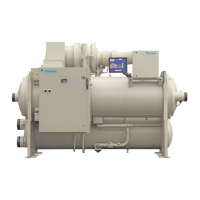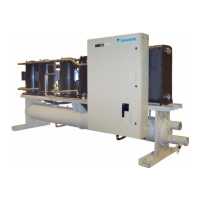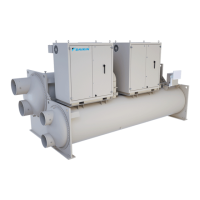Do you have a question about the Daikin WDC 126 and is the answer not in the manual?
Instructions for inspecting and safely handling the Daikin centrifugal water chillers upon receipt, including rigging considerations.
Guidelines for properly siting and mounting the centrifugal chillers on a level base, ensuring adequate service clearance.
Provides guidelines for water pump selection, vessel drains, evaporator and condenser water piping, and insulation.
Illustrates insulation placement requirements for cooling-only centrifugal chiller units, indicating areas to insulate or not.
Shows specific areas for insulation on chiller components like tube sheets, motor terminal boxes, and chiller heads.
Presents data for water-cooled oil coolers, including flow rates, temperatures, and pressure drops for WSC units.
Tabulates relief valve locations, pressure settings, and discharge capacities for various Daikin chiller components.
Provides guidance on compressor power wiring, phase sequence, and motor rotation requirements for safe operation.
Provides step-by-step instructions for mounting the terminal box on 10/11kV compressor motors, ensuring proper alignment.
Describes methods for insulating motor terminals and housing using thermal foam, sealant tape, and heat shrink tubes.
Explains how power leads are brought into the terminal box and connected to the landing points for compressor terminals.
Describes field wiring requirements between the motor terminal box and chiller control panel for transmitting motor information.
Outlines three sources for supplying control power to the chiller: factory-mounted starter, freestanding starter, or separate circuit.
Describes the Daikin MicroTech II control system, including operator touchscreen, unit control panel, and compressor control panel.
Offers guidance on lubrication servicing, emphasizing caution and the necessity of trained personnel for maintenance.
Details maintenance tasks for the electrical system, including checking current draw, oil heaters, protection controls, and motor resistance.
Outlines procedures for annual shutdown and startup, including draining water, electrical checks, and safety precautions.
Provides procedures for replacing leaking pressure relief valves using a three-way shutoff valve.
Explains the process of pumping down the refrigerant system, emphasizing care to avoid evaporator freezing.
Details pressure testing and leak testing procedures for systems with potential damage or lost refrigerant charge.
Describes evacuating the system to microns and charging the refrigerant system after repairs.
Explains the importance and interpretation of oil wear metal analysis for assessing internal chiller condition.
Lists daily, weekly, monthly, quarterly, and annual maintenance tasks for the chiller unit, compressor, and lubrication system.
Outlines tasks for storing units, including leak testing, visual inspection, pressure checks, and protection against humidity.











